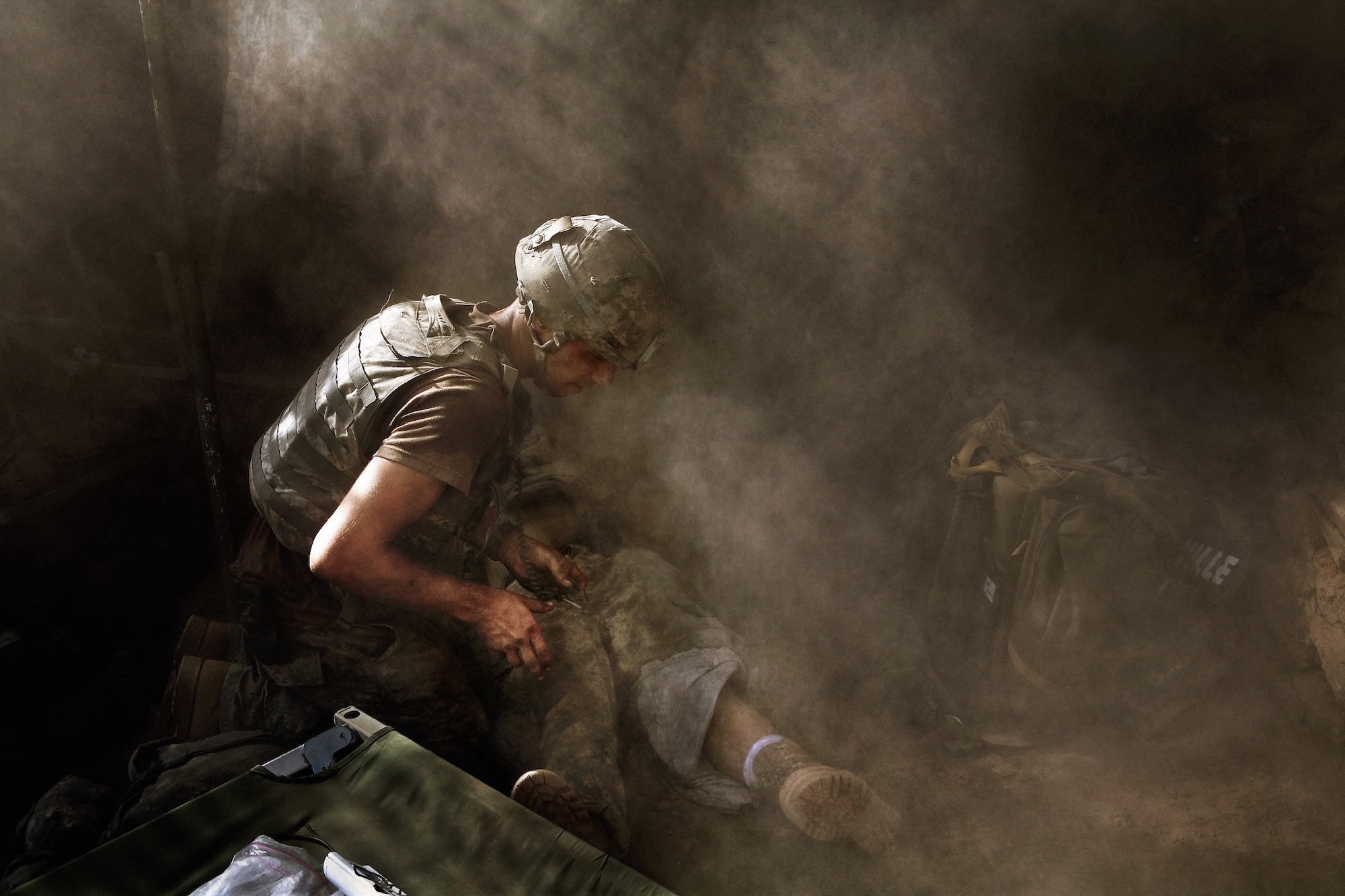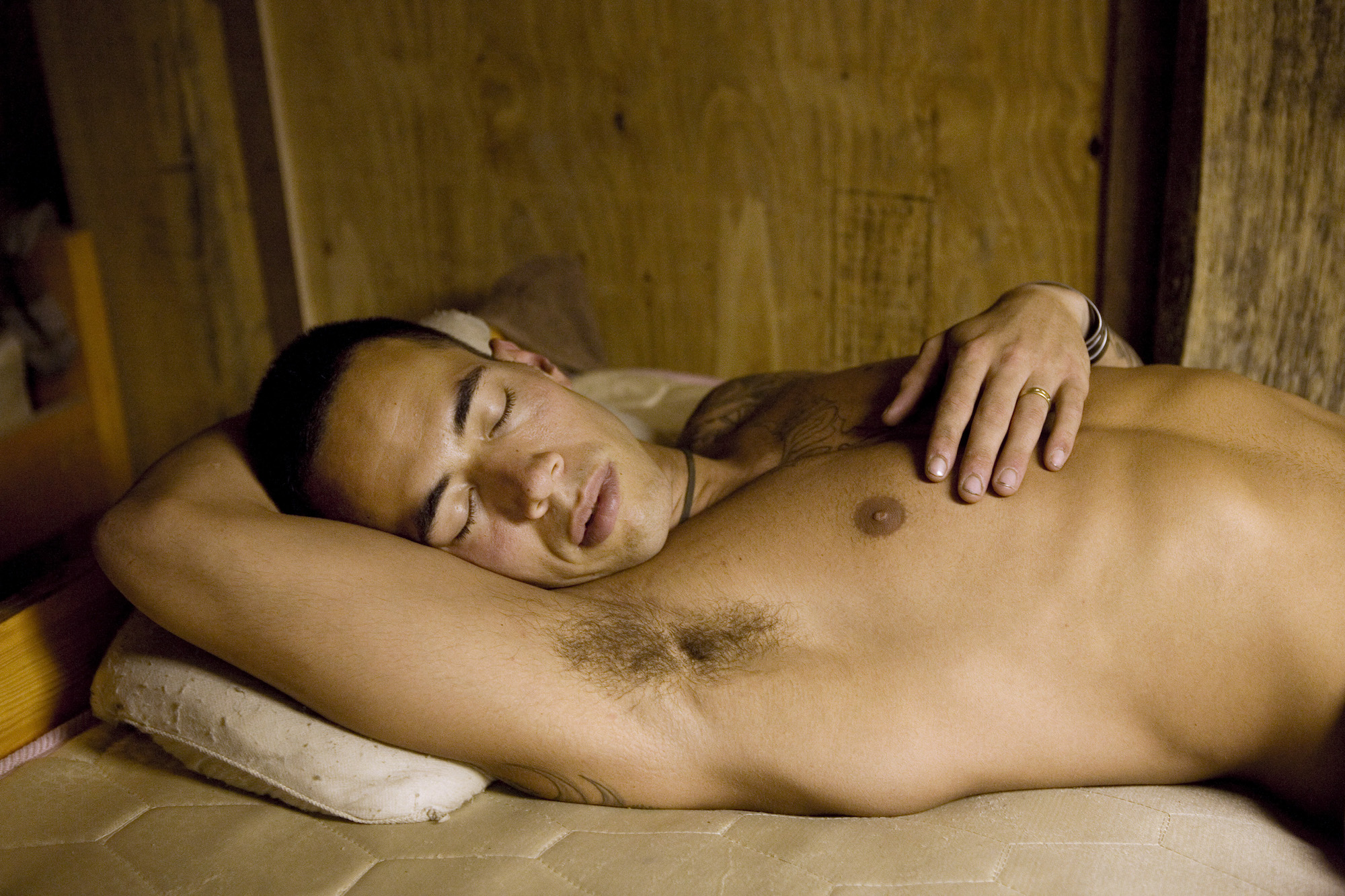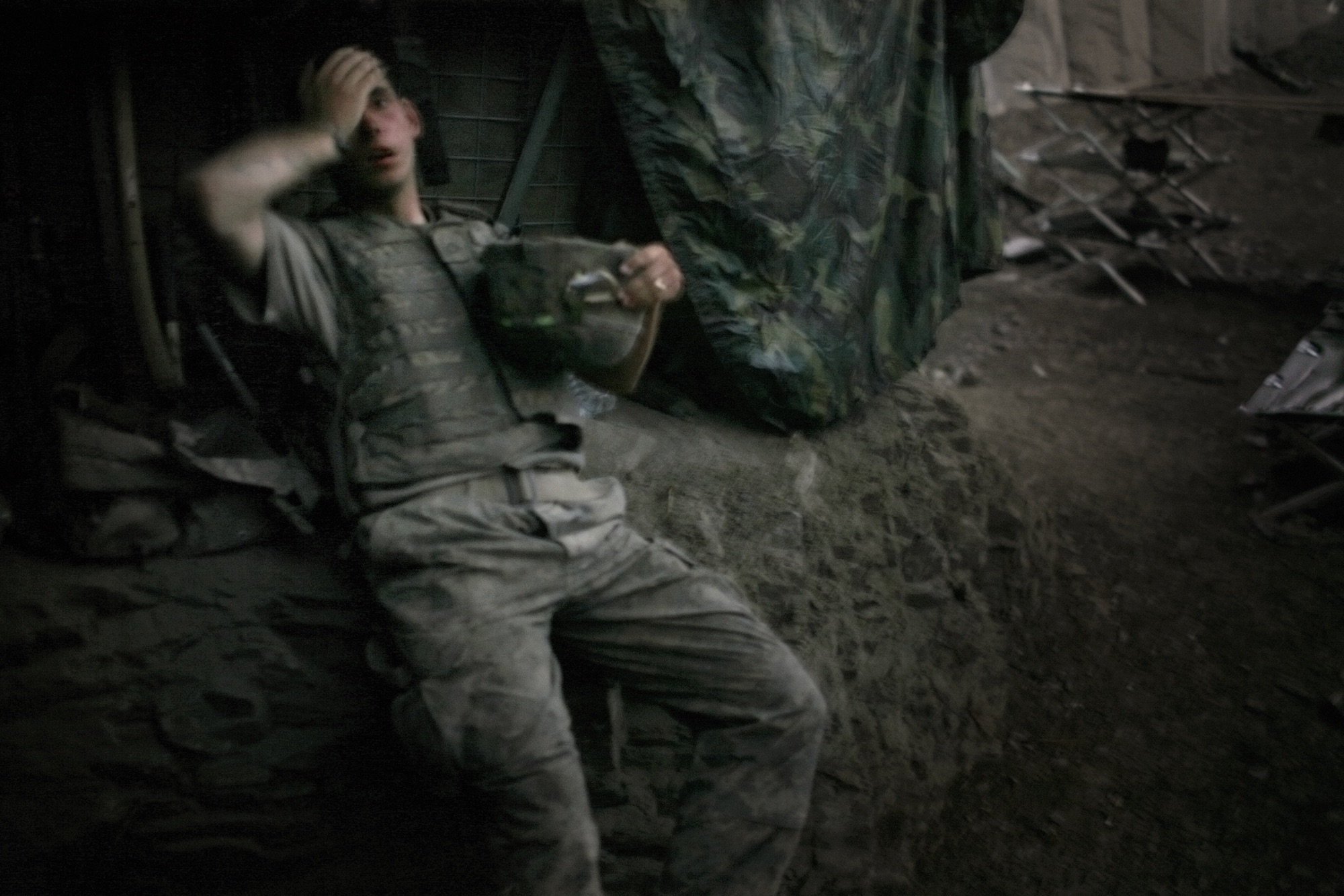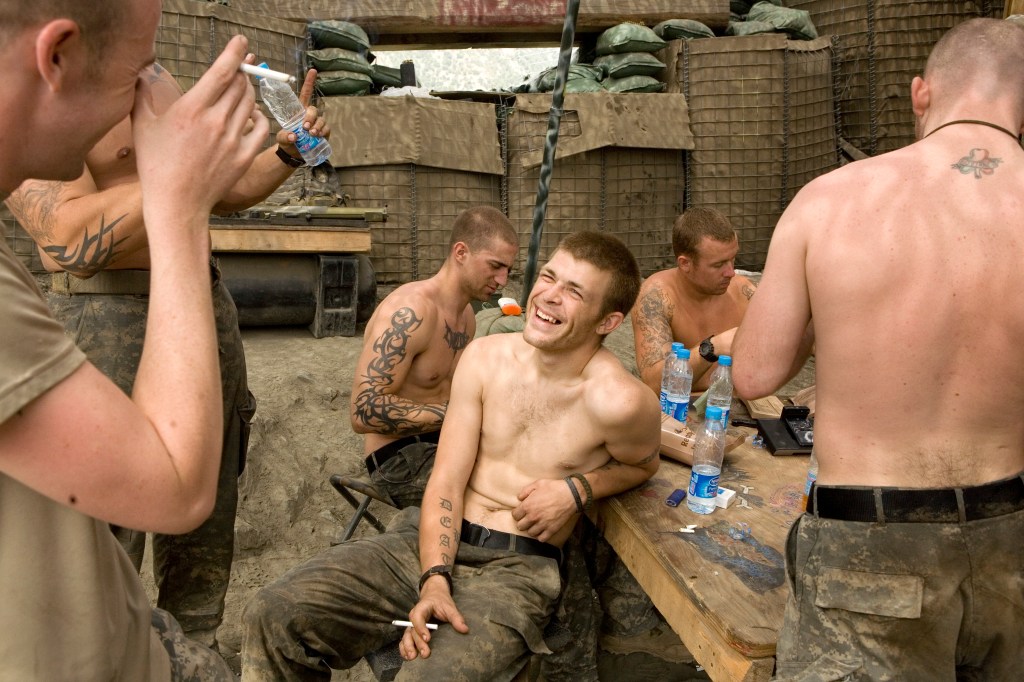On April 20, 2011, two months into the Libyan Civil War, British photojournalist Tim Hetherington was on the front lines with rebel forces at Misrata when tragedy struck. Gaddafi forces blasted his group, killing photographer Chris Hondros and gravely wounding photographer Guy Martin. Hetherington was wounded by shrapnel and survived the attack, only to die later from excessive blood loss.
Hetherington abhorred violence, but he took it upon himself to explore the subject of war on the front lines, alongside soldiers in Liberia, Afghanistan, and Libya. While embedded in Afghanistan on assignment for Vanity Fair (for which he won the 2007 World Press Photo of the Year), Hetherington came to understand war as a function of male sexuality.
Videos by VICE

Hetherington had an epiphany, thanks to a photograph he called “The Garden of Eden,” which showed American soldiers picnicking in the country. He believed a primal yearning for conflict and the threat of imminent death allowed men the opportunity to openly express love for one another without doubt, fear, or judgment. He thought true depictions of masculinity couldn’t be found in heroic, dramatic, or otherwise artistic representations of war. It lay in casual snapshots of soldiers in their most intimate and vulnerable moments.
Stephen Mayes was Hetherington’s longtime friend and colleague; he’s now the the Executive Director of the Tim Hetherington Trust. To commemorate the seventh anniversary of his death, VICE spoke with Mayes about how Hetherington changed the way we think about war. He also talked about his final conversation with Hetherington, in which the photographer shared how his time on the front lines changed his life.

VICE: How would you describe Tim Hetherington’s mission?
Mayes: I met Tim while he was studying photojournalism at Cardiff University in Wales. From the moment he graduated in 1997, he was beyond photography. For the rest of the 90s, our conversation was, “That’s all very well, but what are you going to do with it?”
Tim never really thought of himself as a photographer. He would use any medium to announce the message: magazine work, a gallery exhibition, a multimedia installation, a book, a film, and all the publicity for everything else to talk about the work. It was never just a photograph; it was a life mission.
I first heard Tim talk about war and male sexuality in 2003. He had done a few years in the bush with the rebel forces in Liberia, which was a pretty brutal life. He lived it, and he was in there for reasons. The pictures were almost incidental. When he came out of the bush, he talked about things that he hadn’t photographed, that he couldn’t. He wanted to know why people do this.

What did he discover about the nature of war?
For Tim, it came down to how the main thing behind conflict is male sexuality—but it’s not sexual. A lot of the issues of maleness are about the inability to express love. We have this very rudimentary view of male sexuality—that it is an on/off switch—and it’s so much more than that. Because there’s no invitation to men to think about it, explore it, or do anything about it (other than “behave yourself”), we’re stuck.
The reason why conflict is so interesting is because that’s where men express themselves; it’s where men were most human, in the most inhuman environment. It’s where he felt they were able to connect with themselves and with each other in ways they could not when they came home. Tim was looking for what it is that contains men and prevents them from being more expressive.

What makes conflict “male?”
In his last conversation with me, Tim talked about why he wanted to photograph the front lines rather than the refugee camps. He felt that the emotional reason was that he was a man, and he wouldn’t be satisfied with being at the refugee camp because he was of the same cut as the men who were fighting.
Tim was struggling to understand what drew him to that. It isn’t as simple as being about territory or money or any of that. He saw it as a profound male need to seek conflict. Yet in his personal life, Tim was an amazingly peaceful man. He was not someone who sought conflict in daily life, yet he was drawn to war. Partly, it’s a sense of adventure. There is also the issue of love. Tim found a sense of love that he couldn’t express anywhere else in his life.
When I say Tim lived it, he really lived it. While he was in Afghanistan on patrol with the soldiers, he broke an ankle and wouldn’t let them help him. He hiked for two days with a broken ankle carrying a backpack across the mountains of Afghanistan to get help. He was of the men and that’s how he came across the idea that soldiers are the software of war.

How did Tim’s time in Afghanistan become the turning point in his career?
When Tim received the Oscar nomination for Restrepo in 2011, he reached the point where he had an audience and something to say about male sexuality and conflict. Sleeping Soldiers, his Vanity Fair work, was the first real foray into that.
Sleeping Soldiers is a meditation. It’s not photojournalism, but it gets read that way even now. If you stop looking at what you expect to see and start thinking about what you might be looking at, Tim’s work often leads you to a different position.
Tim had been sleeping in the camp for months on end, and apart from the explosions, nothing much was happening. No one was surprised when he took pictures of the soldiers horsing around but to pick up the camera, creep around, and take pictures while they were asleep was very puzzling.
Tim told me, “This is about more than passivity. This is about being.” Stripped of their uniforms, these men were very different. Tim explained that the American soldier is an international trademark as recognizable as Coca Cola. The soldiers are the brand until you take the clothes off. Then suddenly they are people. Photographing the men half naked and asleep in the middle of the fiercely contested conflict in Afghanistan reminds people of vulnerability and aggression.

It’s interesting you said that Sleeping Soldiers is not photojournalism. What photos are considered “photojournalism?”
Essentially journalism is a process of exclusion. For example, if you were photographing a famine, you wouldn’t show people going to the store to buy food, even though they do. It’s contradictory. Photojournalism doesn’t accept that. It identifies one individual or scenario to represent larger problems.
The notion of cliché has a function, which is that it brings us to ideas very quickly, and that’s very useful. For example, if you have a front-page picture, you know what that is, even if you haven’t read the story. The code is there, whether it is war, poverty, or famine. Photojournalism is about fulfilling your expectations about what you are about to see. The media is not in the information business. It’s in the affirmation business.

What are the tropes of war, and how did Tim go beyond this?
The tropes are the hardware: uniform, the equipment, and the gear. Tim wanted to talk about the software: the people. He wanted to show the same people in the very conflict without their props or with the props rearranged in a way that revealed the narrowness of conventional reporting. The mission was not to expose journalists. Tim was trying to expand what had been done. He wanted to talk about things that couldn’t be said in places that didn’t want to hear them.

Could you speak about the turning point in Tim’s career?
I remember vividly that he walked into my office in DUMBO. He didn’t say a word. He just pulled out contact sheets of work made in Afghanistan and asked what I thought of the photos. There was something happening here that was beyond conventional war photography. I honed in on the men playing, tweaking each other’s nipples, making contact with their shirts off. It wasn’t sexual or erotic but at the same time it allowed them the freedom of expression. That’s what he was trying to say: This looks different.
With Sleeping Soldiers, Tim told the expected story from every possible angle. He won the World Press Photo of the Year prize because there was nothing more to say. Tim recognized that all he could do was repeat himself.
That’s why the “Garden of Eden” photograph became his pivotal picture. He didn’t get it while he was making it, he got it while he was looking at it. He realized that what mattered most to the soldiers was not the fighting—it was being out on a sunny day in the country enjoying each other’s company.

How does Tim’s work help us understand the significance of male sexuality?
Here the truth is exposed and the truth is not that men carry guns. The truth is about these deeper things. Tim wanted to talk about it in ways that wouldn’t be challenging—we don’t want to challenge men because then we get the usual reaction. It has to be about getting to men from the inside: recognition.
Tim was feeling something and wanted to know why people don’t recognize it. And of course we do, we just don’t talk about it, or we deflect. That’s what he was trying to get around. He wasn’t trying to make people feel uncomfortable. It was just the opposite. Tim wanted people to feel comfortable in the reality of their lives. From our little realities, the world is made. We should be able to talk about this.
Sign up for our newsletter to get the best of VICE delivered to your inbox daily.
Follow Miss Rosen on Instagram.




